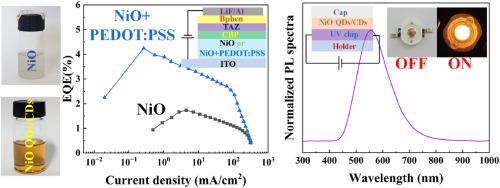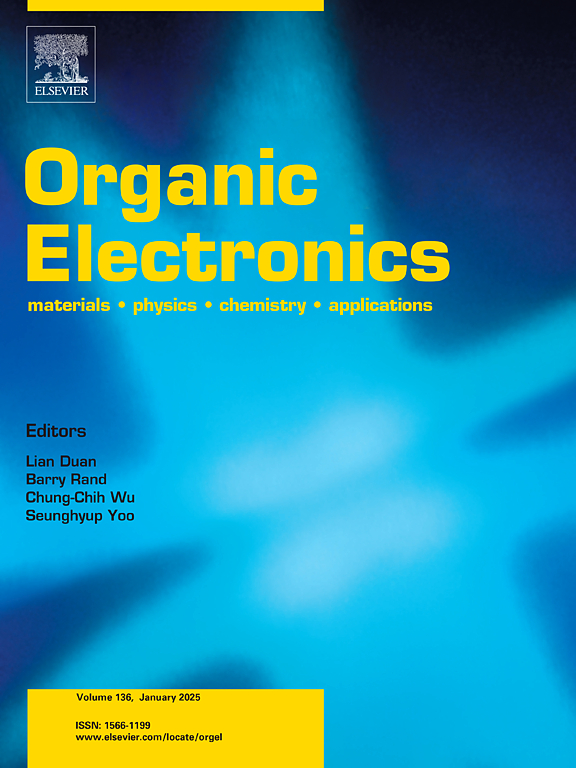溶液处理NiO裁剪孔注入和增强发光二极管的光致发光
IF 2.6
4区 工程技术
Q3 MATERIALS SCIENCE, MULTIDISCIPLINARY
引用次数: 0
摘要
溶液处理NiO介质发光二极管(led)的性能已被证明。利用掺杂nio的聚(3,4-乙烯二氧噻吩):聚苯乙烯磺酸盐裁剪空穴注入,制备出了外量子效率最高4.24%、发光强度为3.9 mW/cm2、短波长为375 nm的紫外有机发光二极管。采用分散在聚甲基丙烯酸甲酯中的混合nio量子点/碳点作为复合荧光膜,365 nm(和395 nm)激发的光致发光led在100 mA(和110 mA)时的亮度分别为22014(和23937)cd/m2,功率效率分别为13.86(和13.00)lm/W,光谱峰约为555nm,半峰宽约为140 nm的黄绿色发光。原子力显微镜、透射电子显微镜、x射线/紫外光电子能谱、电流电压、光致发光、阻抗谱和电导率测量证实,NiO掺杂聚(3,4-乙烯二氧噻吩):聚(苯乙烯磺酸盐)促进了有机led的空穴注入,NiO的掺入增强了碳点的光致发光,从而提高了器件的性能。我们的实验为构建迷人的led和促进NiO应用提供了替代方法。本文章由计算机程序翻译,如有差异,请以英文原文为准。

Solution-processed NiO tailoring hole injection and enhancing photoluminescence in light-emitting diodes
Solution-processed NiO mediating light-emitting diodes (LEDs) performance have been demonstrated. Using NiO-doped poly(3,4-ethylenedioxythiophene):poly(styrenesulfonate) tailoring hole injection, fantastic UV organic LEDs with maximum external quantum efficiency of 4.24 %, radiance of 3.9 mW/cm2, and 375 nm short-wavelength emission are demonstrated. Using hybrid NiO-quantum dots/carbon dots dispersed in poly(methyl methacrylate) as composite fluorescence film, the 365-nm (and 395-nm) excited photoluminescent LEDs show high luminance of 22014 (and 23937) cd/m2 at 100 mA (and 110 mA), power efficiency of 13.86 (and 13.00) lm/W, and yellow-green emission with spectra peak of about 555 nm and wide full width at half maximum of about 140 nm. Atomic force microscope, transmission electron microscope, X-ray/ultraviolet photoelectron spectroscopy, current-voltage, photoluminescence, impedance spectroscopy, and conductivity measurements confirm that NiO-doped poly(3,4-ethylenedioxythiophene):poly(styrenesulfonate) promotes hole injection in organic LEDs, NiO incorporation enhances photoluminescence of carbon dots, and accordingly contributing to superior device performance. Our experiments provide alternative methods for constructing fascinating LEDs and boosting NiO applications.
求助全文
通过发布文献求助,成功后即可免费获取论文全文。
去求助
来源期刊

Organic Electronics
工程技术-材料科学:综合
CiteScore
6.60
自引率
6.20%
发文量
238
审稿时长
44 days
期刊介绍:
Organic Electronics is a journal whose primary interdisciplinary focus is on materials and phenomena related to organic devices such as light emitting diodes, thin film transistors, photovoltaic cells, sensors, memories, etc.
Papers suitable for publication in this journal cover such topics as photoconductive and electronic properties of organic materials, thin film structures and characterization in the context of organic devices, charge and exciton transport, organic electronic and optoelectronic devices.
 求助内容:
求助内容: 应助结果提醒方式:
应助结果提醒方式:


